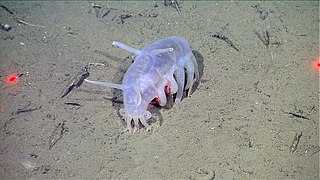
Sea cucumbers are echinoderms from the class Holothuroidea. They are marine animals with a leathery skin and an elongated body containing a single, branched gonad. Sea cucumbers are found on the sea floor worldwide. The number of holothurian species worldwide is about 1,717, with the greatest number being in the Asia-Pacific region. Many of these are gathered for human consumption and some species are cultivated in aquaculture systems. The harvested product is variously referred to as trepang, namako, bêche-de-mer, or balate. Sea cucumbers serve a useful role in the marine ecosystem as they help recycle nutrients, breaking down detritus and other organic matter, after which bacteria can continue the decomposition process.

The Decapoda or decapods are an order of crustaceans within the class Malacostraca, including many familiar groups, such as crabs, lobsters, crayfish, shrimp and prawns. Most decapods are scavengers. The order is estimated to contain nearly 15,000 species in around 2,700 genera, with around 3,300 fossil species. Nearly half of these species are crabs, with the shrimp and Anomura including hermit crabs, porcelain crabs, squat lobsters making up the bulk of the remainder. The earliest fossil decapod is the Devonian Palaeopalaemon.

Holothuria is the type genus of the marine animal family Holothuriidae, part of the class Holothuroidea, commonly known as sea cucumbers. Members of the genus are found in coastal waters in tropical and temperate regions. They are soft bodied, limbless invertebrates that dwell on the ocean floor and are usually detritivore. They resemble a cucumber in form. The genus contains some species that are harvested and sold as food.

Scotoplanes is a genus of deep-sea sea cucumbers of the family Elpidiidae. Its species are commonly known as sea pigs.

Niphopyralis is a genus of snout moths of the subfamily Spilomelinae in the family Crambidae.

Enypniastes is a genus of deep-sea sea cucumber. It is monotypic, being represented by the single species Enypniastes eximia. Due to its unique appearance, the species has been dubbed the headless chicken fish, headless chicken monster, and the Spanish dancer. It is also known as the swimming sea cucumber, and some are called the pink see-through fantasia.

Elasipodida is an order of sea cucumbers. They have numerous appendages, including conical papillae and leaf-like tentacles. Although many species are benthic, a number are pelagic, and may have their appendages modified to form sails or fins. Most members of the order inhabit deep-sea environments, such as the species of the genus Enypniastes.

Crustaceans may pass through a number of larval and immature stages between hatching from their eggs and reaching their adult form. Each of the stages is separated by a moult, in which the hard exoskeleton is shed to allow the animal to grow. The larvae of crustaceans often bear little resemblance to the adult, and there are still cases where it is not known what larvae will grow into what adults. This is especially true of crustaceans which live as benthic adults, more-so than where the larvae are planktonic, and thereby easily caught.

Pelagothuriidae is a family of deep-sea swimming sea cucumbers. They are somewhat unusual in appearance, in comparison with other sea cucumbers, having numerous appendages, including conical papillae and leaf-like tentacles. Most of them are benthopelagic, which means that they are able to swim for a time from the bottom : the species Pelagothuria natatrix is the only true pelagic holothurian ; it looks like a jellyfish. Most members of the order inhabit deep-sea environments, like Enypniastes.

Elpidiidae is a family of deep-sea sea cucumbers.

Elpidia is a genus of deep-sea sea cucumbers. Members are characterised by their rod-shaped spicules which each have two pairs of obliquely-placed horizontal arms and two vertical apophyses. There is a high degree of endemism in this genus with different species occupying different deep sea basins or regions.
Peniagone is a genus of deep-sea sea cucumbers in the family Elpidiidae. Peniagone wyvillii is the type species.
Ellipinion is a genus of deep-sea sea cucumbers in the family Elpidiidae. It was first described by the French marine biologist Edgard Hérouard in 1923.
Spruce sawflies are various sawfly species found in North America that feed on spruce. There are multiple species of sawflies known as spruce sawflies, including species in the genera Gilpinia, Pikonema, Pristiphora, and Cephalcia. Each kind of sawfly attacks particular parts of the spruce as larvae during different times of the year.

Psolus is a genus of sea cucumbers in the family Psolidae, marine animals with long bodies, leathery skins and tentacles, that inhabit the sea bed.

Psychropotidae is a family of deep-sea swimming sea cucumbers. The geographic range of some psychropotids is very extensive at abyssal depths, whereas other species are found within more restricted ranges.

Benthodytes is a genus of sea cucumbers in the family Psychropotidae.
Psycheotrephes is a genus of sea cucumbers in the family Psychropotidae.

Mesothuria is a genus of sea cucumbers belonging to the family Synallactidae. The genus has a cosmopolitan distribution.

Pseudostichopus is a genus of sea cucumbers belonging to the monotypic family Pseudostichopodidae. The genus has a cosmopolitan distribution.















